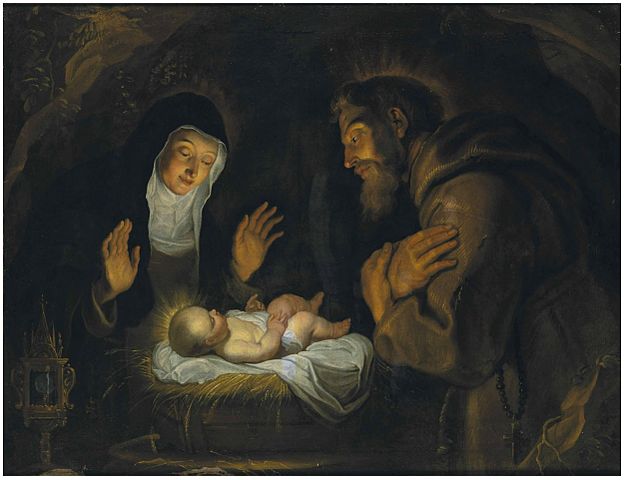 by Theresa Cavicchio
by Theresa CavicchioTo view the feast of Christmas through Franciscan eyes, we turn to the two saints who most embody that spirituality: its founder, Saint Francis of Assisi (1182 - 1226), and his beloved spiritual daughter, Saint Clare of Assisi (1193 - 1253). One of many hallmarks of Franciscan spirituality which they shared was a deep, intense love for the Incarnation of Jesus Christ, the Word made flesh, in the poverty of His birth. Both were gifted with evidence of this love in miraculous ways.
~ Francis ~
The connection between Saint Francis of Assisi and the Nativity scenes in our homes and churches is not exactly what we’d call common knowledge. In fact, for many, the news that Saint Francis arranged the first re-enactment of the birth of Jesus eight centuries ago possibly would come as quite a surprise.
As John Quigley, OFM, writes: “In his exuberance and passionate love for the incarnation of God that is revealed in Jesus of Nazareth, Francis invented a dramatic way to preach about this mystery. In 1223 he created the first Christmas crib so that the people around the Italian village of Greccio could have a practical and personal experience of the incarnation of Jesus and what it meant for ordinary people” (Franciscan Spirit: St. Francis and the Incarnation).
In The Life of Saint Francis, Thomas of Celano relates the saint’s desire “to enact the memory of that babe who was born in Bethlehem: to see as much as is possible with my own bodily eyes the discomfort of his infant needs, how he lay in a manger; and how, with an ox and an ass standing by, he rested on hay.”
A faithful friend of Francis arranged all just as the saint desired, including live animals. Midnight Mass was celebrated in the crude torch-lit surroundings, friars and villagers in attendance. In his capacity as deacon, Francis intoned the Gospel and preached the homily, his voice betraying his intense emotion.
An atmosphere of joyful anticipation suffused the heaven-blest scene. Celano relates the Christmas Eve miracle: a “virtuous man” in the company saw Francis approach the previously empty manger and lovingly lift a child lying there, waking him “from a deep sleep.”
The miracle continued even after the company dispersed to their homes, filled with the peace and joy of the first Christmas creche experience. According to tradition, the hay from that holy manger proved efficacious for healings of both humans and animals in time to come.
~ Clare ~
Like Francis, Clare held the Incarnation, clothed with the mantle of poverty, close to her heart. In her book entitled Franciscan Prayer, Ilia Delio writes that for Clare, “poverty was the key to Christian life. The Incarnation spoke to her of the ‘poverty of God’ manifested in God’s self-giving love.”
The Christmas Eve miracle which Clare experienced occurred in 1252, many years after Francis’ death and less than a year before her own. Her final years on earth had seen her bedridden as her health, never robust, continued to decline.
In a 1993 letter to Saint Clare’s cloistered Sisters, Pope Saint John Paul II summarized her miracle: “On Christmas Eve in 1252, the Child Jesus bore Clare far away from her bed of illness and love, which knows neither time nor place, and enveloped her in a mystical experience which immersed her in the infinite abyss of God.”
Too ill to accompany her Sisters to the Church of Saint Francis for Midnight Mass, Clare lay in her bed, alone and lamenting the loss of spiritual comfort and reception of Holy Eucharist on that most holy of nights.
The Little Flowers of St. Francis of Assisi relates that when the Sisters returned to their convent at San Damiano, they voiced their sorrow that Clare wasn’t able to be with them to experience the spiritual consolations they had received.
Clare replied that she had indeed “assisted at all the solemnities of this most holy night,” with all of its spiritual benefits: “for by the intercession of my father, St. Francis, and through the grace of Our Savior Jesus Christ, I was personally present in the church of my venerable father, St. Francis, and with the ears of my body and those of my spirit I heard the entire Office, and the sounds of the organ, and the singing, and likewise received Holy Communion. Rejoice, then, because of these graces which I have received, and offer prayers of thanksgiving to Our Lord Jesus Christ.”
Witness testimony given during the Process of Canonization confirms the recounting of this extraordinary spiritual gift for a beloved daughter of God and of Saint Francis on her final Christmas on earth.
The letter of Pope Saint John Paul II references Saint Clare’s 4th Letter to Saint Agnes of Prague, written shortly before Clare’s death the following summer. The Holy Father writes, “Clare, bowed down in contemplating the Infant of Bethlehem, exhorts us: Since this vision ‘is the splendor of eternal glory, the brilliance of eternal light and the mirror without blemish, gaze upon that mirror each day … Look at … the poverty of him who was placed in a manger and wrapped in swaddling clothes. O marvelous humility! O astonishing poverty! The King of angels, the Lord of heaven and earth, is laid in a manger.’”
The Christmas miracles experienced by Saint Francis and Saint Clare were born of their shared passionate love for Jesus, the Son of God incarnate, whose poverty became a foundational element of Franciscan spirituality. These holy people can inspire us to make some changes in our lives -- even very small changes -- away from our modern focus on materialism and toward a true poverty of spirit. In this way, we can experience Christmas miracles in our own hearts -- for a truly Franciscan Christmas that lasts all year long.
© All Rights Reserved, Living His Life Abundantly®/Women of Grace® http://www.womenofgrace.com
